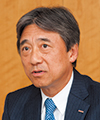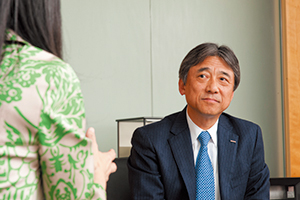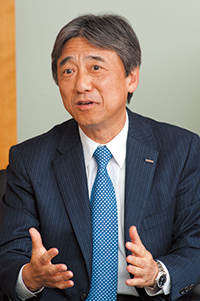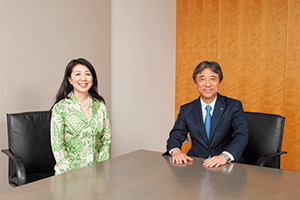 |
|||||
|
|
|||||
|
View from the Top Vol. 13, No. 2, pp. 1–5, Feb. 2015. https://doi.org/10.53829/ntr201502tp1  Build a Feedback Loop for Value Creation—Enriching and Accelerating Open Innovation in 2015OverviewToday, feature phones and smartphones have become indispensable in our daily lives, and users are looking for even more convenient mobile devices that provide a greater sense of beneficial value. At the same time, the convergence of mobile and fixed communications has the potential to bring dramatic changes to the way that we communicate with others. We asked Kazuhiro Yoshizawa, NTT DOCOMO Senior Executive Vice President, to tell us about the types of mobile-fixed services that NTT DOCOMO plans to provide and the company’s approach to innovation as a foundation of service creation. Keywords: open innovation, feedback loop, Hikari Collaboration Model Facing 2015 with a sound attitude: “Of thy sorrow be not too sad, of thy joy be not too glad”—Mr. Yoshizawa, please tell us about the current state of NTT DOCOMO and the outlook for 2015 from your position as Senior Executive Vice President. NTT DOCOMO has downwardly revised its forecasts of financial results for the 2014 fiscal year ending in March 2015. The 2015 fiscal year will be a time for us to revitalize our competitive edge. In addition to a new billing plan called “Kake-hodai & Pake-aeru,” we are rolling out novel services such as “docomo Hikari” as part of our aggressive approach to further enhancing customer satisfaction. Having said that, we have to bear in mind that the competitive edge should come from our customers’ strong need for NTT DOCOMO services and not from the one-sided assumption of what our competitive abilities should be. Talking of my position at NTT DOCOMO, in contrast to the formulation of company-wide strategies I was engaged in, my current responsibilities involve dealing with specific fields such as technologies, information systems, information security, personal or confidential information, and devices. In the area of information security, for example, questions were raised last year about the safety of personal information. In the face of such data security concerns, it is my job to increase our awareness that we are entrusted with the huge amount of personal information and to enhance our countermeasures against data leaks. To provide our president with solid support and to fulfill my responsibilities, I need to be calm and collected during difficult times without losing sight of what is really happening, and I must be careful about being overoptimistic during good times. The words that I like to live by are, “Of thy sorrow be not too sad, of thy joy be not too glad.” —What, then, will be your specific strategies? To begin with, please tell us about the enthusiasm that NTT DOCOMO has for the Hikari Collaboration Model [1]. As you know, we plan to provide our customers with a service called “docomo Hikari” by purchasing FLET’S HIKARI (a high-speed optical fiber Internet connection service) from NTT EAST and NTT WEST on a wholesale basis. In this move, we are determined to play a B2C (business-to-consumer) role within the entire NTT Group by leveraging our experience in providing customers with feature phones and smartphones. Our key role here is to set up an optimal broadband environment for our customers so that they can seamlessly enjoy mobile and fixed services, rather than just setting new billing plans including package discounts. For example, this means creating a seamless environment in which customers can continue to enjoy their digital content even away from home as they always do at home. This would be an area where NTT DOCOMO is expected to provide new services by leveraging NTT EAST and NTT WEST services for users including those at home. Meanwhile, the mobile domain is still our business platform. It goes without saying that it will continue to be an important pillar of NTT DOCOMO business. However, the use of voice services is declining, so we have to take a composite approach of bolstering voice services and improving profitability in data communications. The new “Kake-hodai & Pake-aeru” billing plan that we announced last year is just part of this initiative. I believe that “voice” lies at the basis of communication. Voice services have traditionally been charged on a volume basis, and as a result, customers have viewed them as being somewhat expensive and have tended to use them sparingly. I considered that applying a flat rate billing scheme to voice services could change this trend to encourage customers to increase their voice communication. What could be better than being able to enjoy phone calls regardless of whether the other party is on a mobile or fixed phone without having to worry about the fee charged? Moreover, to further promote the use of voice, we have developed a high-quality voice service called VoLTE (Voice over Long Term Evolution). Of course, one can convey one’s thoughts and intentions through text and graphics using e-mail or social networking services (SNS). Nevertheless, I would like to see our customers deepen exchanges of more subtle and nuanced emotions by using one-to-one, high-quality calls using their own voice—the basis of human communication. As for data communications, we have prepared plans that offer a variety of benefits for our customers. These include the sharing of packet quotas among family members and the ability to carry forward unused packets to the next month. My goal here is to combine this initiative with business in new areas to bolster revenues in the mobile domain.
Build a feedback loop for value creation—What areas would you look to first in launching a new business? As a leading company specializing in the communications business, we will place our primary emphasis on voice, data communications, and e-mail as before. Now, “service” has been added to the list of important areas where we compete. “Service” can be interpreted as something convenient and enjoyable to use from the viewpoint of the customer. That means we need to identify the applications and content useful for customers’ lives as the Internet is playing an indispensable role for them. In this context, we must determine what services to be provided for what types of customers through marketing, which is essential and will become the key element of our business. At the same time, we need to be keenly aware of the competition. It’s not just other telecommunication carriers in Japan. We are facing the competition from the so-called Over The Top (OTT) global service providers such as Amazon*1 and Facebook*2. So it’s important for us to pursue service creation, keeping the competition in mind. To this end, it is essential to enhance our research-and-development and product-planning capabilities so that we can create and provide services as quickly as possible, incorporating the voices of our customers. I always tell the employees, “Look through the eyes of the customer. Then you will see what they really need.” Without building a feedback loop that promptly reflects the voices of our customers, we cannot win in the service competition.
—Is preparation for a future mobile network steadily underway? We are building up and expanding the network as we roll out new services. Data traffic is showing a two-fold increase annually. To accommodate such rapidly growing traffic, we are launching a fourth-generation mobile communication system called LTE-Advanced at the end of this fiscal year. As even this will still not be sufficient to keep up with the traffic growth, we would like to roll out a fifth-generation mobile communication system in time for the “big event” in 2020. To achieve this goal, we have already initiated joint research with six global vendors from Japan and other countries while trying to contribute to the standardization of this fifth-generation mobile communication system as one of the leading companies. In fact, we already have a track record of contributing to standardization efforts. The mobile industry in Japan has often been referred to as being suffering from the “Galápagos syndrome” due to its development of specialized products that are isolated from the rest of the world, but this is not the case. The Personal Digital Cellular (PDC) network technology running the “i-mode” mobile Internet service is an international standard, which happened to be adopted by few countries. The PDC system, moreover, brought in the largest profits in NTT DOCOMO’s history. In addition, the current LTE technology standardized through the leadership of NTT DOCOMO has been adopted in many countries. As for a fifth-generation mobile communication system, the six companies with whom we are conducting joint research toward standardization are all global players, so there is no worry about the Galápagos syndrome. When it comes to commercialization, however, relying solely on Japanese vendors would not be sufficient to achieve global penetration. It is therefore essential that we cooperate and collaborate globally even prior to technology standardization. Enrich and accelerate open innovation with an eye to the “big event”—What type of approach do you intend to emphasize this year to expand NTT DOCOMO activities? As I mentioned earlier, a variety of players are active at the service layer in the global market. As we cannot compete without pursuing development in a more open manner and creating services in a short period of time, I am committed to promoting open innovation in the company. Although the research and development of core technologies requires a good deal of time, we are now in an era in which speedy commercialization in one or two months is needed for some types of services. To keep pace with such a rapid flow, we established the Innovation Management Department just last year. Actually, we have already practiced open innovation to create some novel servcies and applications. Among those are a voice agent application called “Shabette Concier,” and automatic voice translation service “Shabette Honyaku.” We were able to bring them to market in a relatively short period of time by combining technologies from both within and outside the NTT Group. Furthermore, leveraging the know-how that we accumulated in creating the above-mentioned services, we established a joint venture called “Mirai Translate,” which aims to develop high-level machine translation technology and services between Japanese and other languages. The translation accuracy we hope to achieve is comparable to a TOEIC*3 Test 700-point level for English. We feel that such a translation service should be helpful in creating a hospitable environment for the many international visitors who will be visiting Japan during the 2020 “big event.” Innovation is not only about developing original and revolutionary technologies. It also includes combining existing technologies in original ways to create new products and services. With this in mind, we aim to join forces with people having all sorts of ideas. To this end, we finance venture companies, create funds, and establish support programs through NTT DOCOMO Ventures, Inc. All in all, my aim is to promote short-term open innovation by making effective use of the Innovation Management Department and NTT DOCOMO Ventures. At the same time, we will be promoting the development of technologies that can contribute to cost reductions. With regard to the network, this means virtualizing network equipment such as servers to cope with the increasing traffic. In addition, we intend to use multi-frequency band antennas, which integrate operations of a variety of frequencies in radio base stations, to help reduce equipment costs.
—Mr. Yoshizawa, could you leave us with a message for all NTT DOCOMO employees? I would be happy to. During my time in the Corporate Sales and Marketing Division, much of my work was devoted to making apologies, and I came to realize the importance of “listening to what people have to say.” This is not limited to customers—lending an ear to your superiors and colleagues can give you marvelous insights. If you feel that someone else’s idea is more reasonable compared to yours, you should incorporate that idea. If you want to grow, start by listening to what other people have to say. They say that the next-generation of devices will be wearable devices. However, it’s not that simple. In the case of the wristwatch, some people have the habit of wearing one while others don’t, and among those who do, some will prefer to wear it on their right hand and others on their left. In other words, one set of service specifications will never satisfy all customers. We have to strive to listen to the voice of our customers and find out appropriate combinations of services and functions that can meet the needs of individual customers. I believe that this way of thinking can foster innovation.
Reference
Interviewee profileCareer highlightsKazuhiro Yoshizawa joined Nippon Telegraph and Telephone Public Corporation (now NTT) in 1979. He has been involved in the mobile phone business since the dawn of the industry. He became NTT DOCOMO Senior Vice President and Managing Director of Corporate Sales and Marketing Department II in 2007, Senior Vice President and Managing Director of Human Resources Management Department in 2011, and Executive Vice President, Managing Director of Corporate Strategy & Planning Department in 2012. He assumed his current position in June 2014. Concurrently, he retains his position as a Member of the Board of Directors, which he assumed in 2011. |
|||||



